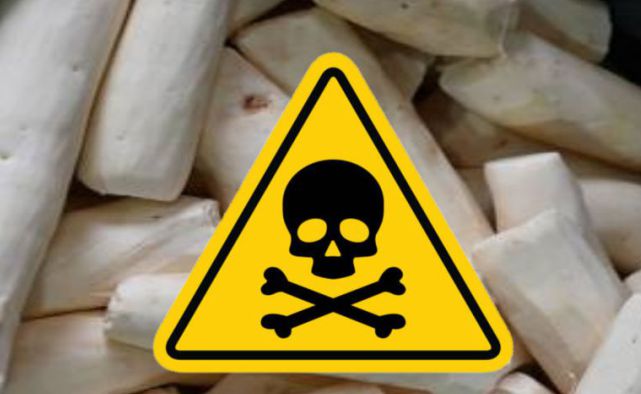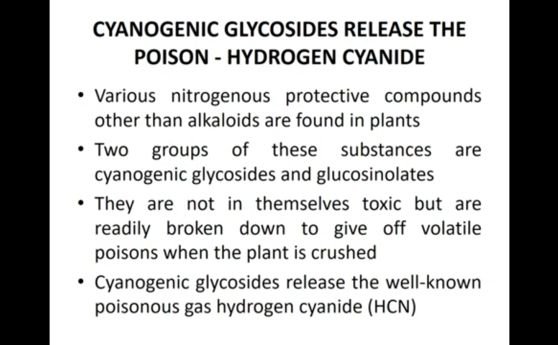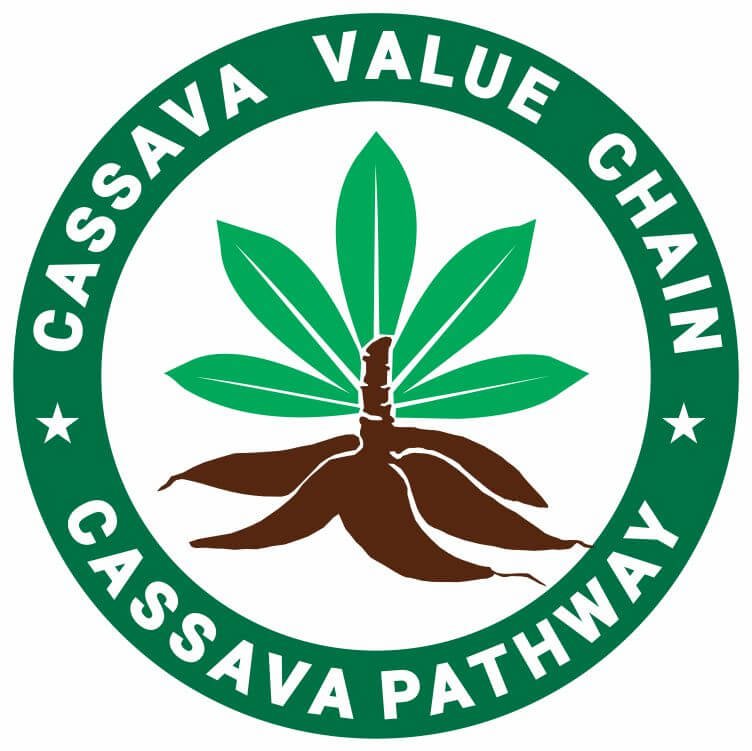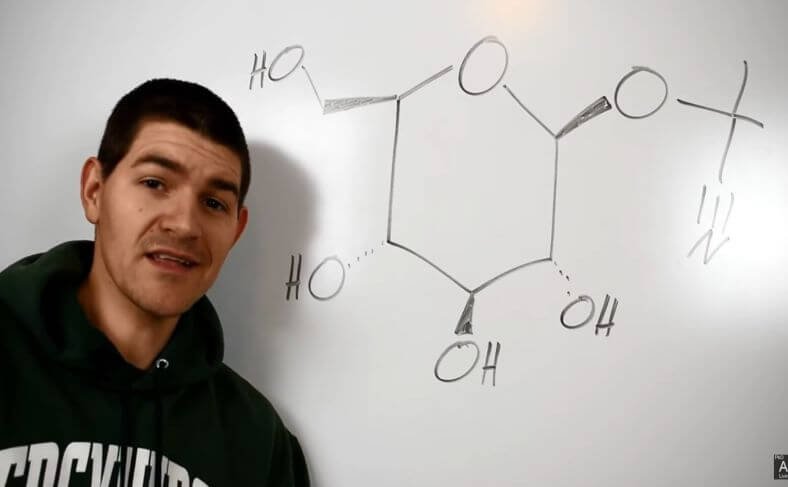Yes! Cassava is poisonous and is capable of causing serious health concerns. Let’s find out how much cassava will kill you if not prepared properly before consumption.
Cassava is a starchy root vegetable that contains natural toxins that can be harmful if not properly prepared.
Though raised in a community where cassava-based food must be eaten every day, we have never experienced any cassava poisoning because our ancestors developed the perfect way to remove the harmful compounds in cassava roots.
Cassava root contains cyanogenic glycosides and hydrogen cyanide, which are the chief components.
Let’s take a look:
Why Cassava is Poisonous (The Toxins)
Cassava is poisonous because it contains cyanogenic glycosides which release hydrogen cyanide when the plant tissue is damaged or digested. This is why it cannot be eaten raw.
The primary threat comes from naturally occurring compounds known as cyanogenic glycosides, which are present in both bitter and sweet varieties of cassava.
When cassava is not prepared correctly, these glycosides can convert into hydrogen cyanide, a potent toxin capable of causing severe health issues, including cyanide poisoning.
The process through which toxicity occurs begins when cassava is damaged, such as during chopping or grating.
This cellular disruption facilitates the enzymatic reaction that converts cyanogenic glycosides into cyanide.
For this reason, improper preparation is a significant risk factor for poisoning.
Bitter cassava contains higher levels of these glycosides, necessitating further caution compared to the sweet variety, which has lower concentrations but still poses a risk if consumed raw.
The more bitter the taste of cassava, the higher the amount of these glucosides, sometimes up to 10-15 mg.
Let’s take a closer look:
Cyanogenic Glycosides in Cassava
Cassava is poisonous as it contains two cyanogenic glycosides: linamarin and lotaustralin.
Linamarin accounts for more than 80% of the cyanogenic glycosides in cassava.
These compounds can release cyanide when the plant tissue is damaged or during digestion.
Cyanide is highly toxic and can cause severe health issues if consumed in large quantities.
Hydrogen Cyanide in Cassava
When cassava is damaged or chewed, the cyanogenic glycosides come into contact with an enzyme called linamarase.
This enzyme breaks down the glycosides, releasing hydrogen cyanide, which is a colorless gas with a characteristic bitter almond odor.
It is extremely poisonous and can be fatal if inhaled or ingested in large amounts.
Related Posts
Cassava and Pregnancy Development
Toxicity Levels
The toxicity of cassava varies depending on the variety. Sweet cassava contains less than 50 mg of hydrogen cyanide per kilogram of fresh weight, while bitter cassava can contain up to 400 mg per kilogram.
The lethal dose of cyanide is approximately 1 mg per kilogram of body weight.
Therefore, it is crucial to properly prepare cassava before consumption to reduce the risk of cyanide poisoning.
How Much Cassava Will Kill You?

Consuming around 100 grams of improperly processed raw cassava could potentially lead to poisoning.
However, when cassava is properly processed, such as by peeling, soaking, and cooking, the cyanide levels are significantly reduced, making it safe to eat.
The key is to prepare cassava correctly to avoid health risks. Always ensure cassava is thoroughly cooked before consumption to eliminate harmful toxins.
Determining the Lethal Dose: How Much Cassava Is Too Much?
Knowing exactly how much cassava will kill you should be uppermost on your mind.
Understanding the lethal dose of cassava requires the consideration of various factors, including the type of cassava, preparation methods, and individual sensitivity to cyanide toxicity.
As we have seen, there are two main types of cassava: sweet cassava and bitter cassava.
Sweet cassava contains lower levels of cyanogenic compounds, making it generally safer to consume without extensive processing.
On the other hand, bitter cassava has higher concentrations of these compounds and necessitates thorough preparation to reduce toxicity.
Research indicates that improperly processed bitter cassava can lead to significant health hazards, as it may contain between 100 to 400 mg of cyanide per kilogram of fresh root.
Ingesting as little as 50-100 grams of the improperly prepared root could lead to dangerous cyanide levels in an adult.
Preparation methods also play a critical role in determining how much cassava can be safely consumed.
Boiling, fermenting, and drying are effective methods to reduce cyanogenic content.
For instance, boiling cassava roots for 30 minutes can decrease cyanide levels significantly.
Studies suggest that consuming boiled sweet cassava in moderation, up to 250 grams per meal, is usually safe for most individuals.
However, those consuming higher amounts, especially from bitter cassava, should exercise caution.
Individual differences must also be taken into account, as some people may have more sensitivity to cyanide than others.
Factors such as age, health status, and genetic predisposition can influence an individual’s response to cyanide ingestion.
Therefore, while discussing lethal doses, it is essential to consider these variabilities.
Expert opinions suggest that community education on proper cassava preparation techniques is imperative in mitigating the associated health risks.
It is crucial to remain informed about the types of cassava and the safe consumption practices to reduce the potential for toxic reactions.
The Mechanics of Cyanogenic Poisoning from Cassava

Cyanogenic glycosides are relatively non-toxic on their own. However, when cassava is processed incorrectly or consumed raw, enzymes break down the glycosides and release hydrogen cyanide.
This highly poisonous gas interferes with cellular respiration by preventing oxygen use at the cellular level.
The lethal dose of hydrogen cyanide for humans, which gives a clue to how much cassava will kill you, is 0.5 to 3.5 mg per kg of body weight. Children are especially at risk due to their smaller size.
Chronic exposure to low levels of cyanide from a monotonous cassava diet can also cause serious health issues like thyroid problems and neurological disorders.
Conditions like tropical ataxic neuropathy and konzo, a paralytic disease, have been linked to long-term cyanide poisoning from improperly processed cassava.
To make cassava safe for consumption, it must be soaked, and dried, and the outer layer removed to degrade the cyanogenic glycosides.
Proper processing is essential to prevent potentially fatal cyanide poisoning, especially in areas where cassava is a dietary staple.
To reduce the toxicity of cassava, it is essential to follow proper preparation methods.
Here are some steps to minimize the risk of cyanide poisoning:
- Peeling: Remove the outer skin of the cassava root to eliminate any surface contaminants and reduce the concentration of cyanogenic glycosides.
- Cutting: Cut the cassava into smaller pieces to increase the surface area exposed to water during soaking and cooking.
- Soaking: Soak the peeled and cut cassava in water for several hours or overnight. This process helps leach out the cyanogenic glycosides.
- Fermentation: Ferment the soaked cassava by allowing it to sit in water for a few days. This process further reduces the cyanide content.
- Cooking: Thoroughly cook the cassava by boiling, steaming, or baking. Cooking helps break down the remaining cyanogenic glycosides and evaporate the released hydrogen cyanide.
Symptoms of Cyanide Poisoning
Acute cyanide poisoning can cause:
- Rapid breathing
- Low blood pressure
- Shortness of breath
- Confusion
- Rapid pulse
- Dizziness
- Headache
- Stomach pain
- Vomiting, and
- In severe cases, coma, and death.
It is noteworthy that the severity of poisoning correlates with the amount of cyanide ingested and the individual’s overall health.
Chronic intake of inadequately processed cassava can lead to more subtle health issues, including goiter and other thyroid-related conditions, due to the consumption of thiocyanate, a byproduct of cyanide metabolism.
Chronic exposure to low levels of cyanide can lead to iodine deficiency, goiter, and tropical ataxic neuropathy, a condition characterized by partial paralysis of the legs.
Frequently Asked Questions
Why is cassava poisonous?
Cassava is poisonous because it contains cyanogenic glycosides, which can release cyanide when the plant tissue is damaged or digested.
What are the cyanogenic glycosides in cassava?
The cyanogenic glycosides in cassava are linamarin and lotaustralin, which can break down to release toxic hydrogen cyanide.
Which of the following poisons that can be found in cassava?
Cassava contains cyanogenic glycosides, which can release cyanide, a highly toxic compound that inhibits cellular respiration.
How is cyanide removed from cassava?
Cyanide is removed from cassava by peeling, soaking, drying, and cooking the root, which helps degrade the cyanogenic glycosides.
Conclusion
Cassava is poisonous and can cause health hazards when it is not prepared properly.
By following the recommended preparation methods, including peeling, cutting, soaking, fermenting, and thoroughly cooking, you can safely enjoy the benefits of cassava while minimizing the potential health risks.
If you experience any symptoms of cyanide poisoning after consuming cassava, seek immediate medical attention.
Citations:
- Cassava: Benefits, toxicity, and how to prepare – MedicalNewsToday https://www.medicalnewstoday.com/articles/323756
- Proximate Composition, Cyanide Content, and Carotenoid Retention … https://www.ncbi.nlm.nih.gov/pmc/articles/PMC7761888/
- Cassava – Wikipedia https://en.wikipedia.org/wiki/Cassava
- Cyanide Poisoning and Cassava – Centre for Food Safety https://www.cfs.gov.hk/english/multimedia/multimedia_pub/multimedia_pub_fsf_19_01.html

Chimeremeze Emeh is a writer and researcher passionate about Africa’s most transformative root crop—cassava. Through his work at cassavavaluechain.com, he explores the entire cassava industry, from cultivation and processing to its diverse applications in food, health, and industrial use.
He also writes for palmoilpalm.com, where he shares his extensive experience and deep-rooted knowledge of palm oil, covering red palm oil, palm kernel oil, and refined products. His work there reflects his lifelong connection to agriculture and his commitment to promoting sustainable value chains in Africa.
Driven by curiosity and purpose, Chimeremeze aims to shed light on how cassava continues to empower communities, strengthen food systems, and link traditional farming wisdom with modern innovation.

